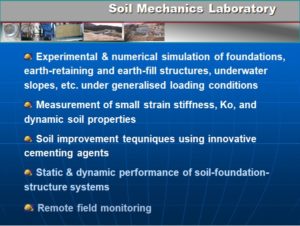Established in 1943 the Soil Mechanics Laboratory of the National Technical University of Athens is equipped with state of the art fully automated apparatuses for advanced element testing of soils and weak rocks. The laboratory research projects cover the study of the strength and deformation characteristics of a wide range of soils; the liquefaction potential of natural and model granular deposits under static and dynamic loading; the methods of stabilization of liquefiable soils using colloidal nano-silica hydrosols and soil improvement techniques using innovative cementing agents; the interrelationship between geotechnical and seismic characteristics of sediments and the effect of sampling on the behaviour of marine sands and saturated and unsaturated clays. Professor Georgiannou was instrumental in developing the Soil Mechanics Research Laboratory.
The Laboratory’s CT scanner was acquired through a sponsored project under the SUB2: “Universities of Excellence” call, with Prof. V.N. Georgiannou as Principal Investigator. In addition to the high-resolution 3D imaging of the interior of the specimens and the AI-driven image processing used for scientific visualization, the apparatus has the size and infrastructure for 4D (Real Time) analysis, by scanning the specimen while it is subjected to external actions; thus the 3D imaging of the evolution of the internal structure during the loading process can be observed in real time, whether loading is due to changes in the stress field, in water/pollutant, heat, gas flow, etc..
As part of the Soil Mechanics Laboratory the Reduced-scale & Numerical Modelling Laboratory facilitates larger scale static and dynamic tests e.g. fault rupture box, laminar box, and a shaking table, to simulate soil-structure systems; an activity led by Emeritus Professor Gazetas. Under the leadership of Professor Gerolymos reduced-scale testing and advanced numerical analysis techniques are developed, to address soil-structure interaction problems as well as to introduce new constitutive models.
The Field Monitoring Laboratory forms part of the research activities of the Soil Mechanics Laboratory through a combination of research projects and practical applications led by Professor Georgiannou. Wireless sensor network systems are developed in-house using MEMS (Micro-Electro-Mechanical Systems) sensors for in-situ monitoring of building and ground movements.
In the Teaching Laboratory the space and resources are provided for the undergraduate students to perform the basic soil mechanics tests and get the most out of the laboratory class.
Quality element testing is performed with:
- a hollow cylinder apparatus which is unique to Greece, and simulates the generalised loading conditions encountered in foundations, earth-retaining and earth-fill structures, underwater slopes, wave action on seabed surface etc.
- The laboratory is also equipped with a range of low, medium and high pressure triaxial stress path cells developed for the static and cyclic loading of soils. They operate at stresses ranging from a few kPa commonly encountered in geotechnical structures, up to10 MPa if we take as an example the soil mass around displacement piles.
- All apparatuses are fully automated and are equipped with up to date local instrumentation mounted on the soil samples to provide accurate and high resolution measurements. The laboratory staff develop, design and build advanced instrumentation aided by a skilled resident technician.
- The X-ray CT scanner is used to relate the evolution of the internal structure to the macroscopic behaviour of geo-materials observed during element testing in the lab.
The testing facilities have contributed to the characterization of natural Greek soils such as the Marls in the Corinth Canal, as well as a range of industrial minerals produced in Greece. With a focus on understanding the liquefaction phenomenon through testing and analysis, a wide range of sands originating from Greece, France, the UK, the Brahmaputra-Jamuna River System in Bangladesh, and marine deposits at Lyttelton Port of Christchurch in New Zealand have been tested in the laboratory to assess their dynamic characteristics and liquefaction potential. The feasibility of using nano-materials to stabilize liquefiable sand deposits has also been explored in the laboratory.
- Reduced-scale experiments on equipment built in-house are used to assess the performance of soil-foundation-structure systems under static, dynamic and seismic loading conditions; the latter are imposed using a 2 tons capacity shaking table.

Hence, the laboratory facilities can be used to determine: the constitutive response at element level on one hand and the behaviour of soil-structure systems on the other; constitutive modelling, numerical analysis techniques and bespoke software are developed for the numerical simulation of the observed response in the laboratory.
In addition to research, the CT scanner is also used in industrial applications such as inspecting the internal structure of relatively large test specimens or components for defects.
The facilities are also used for academic and commercial research projects on:
